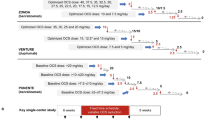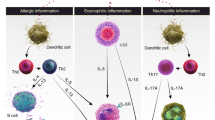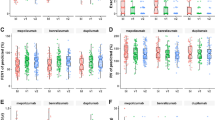Abstract
Introduction
Data on the clinical efficacy and remodeling of omalizumab therapy in patients on oral corticosteroids (OC) are limited.
Objective
The purpose of the study is to show that in patients with corticosteroid-dependent asthma, omalizumab is a corticosteroid-sparing therapy able to inhibit airway remodeling and to reduce disease burden (lung function impairment, exacerbations).
Methods
This study is a randomised open-label study evaluating the addition of omalizumab to the standard of care in patients with severe asthma receiving oral corticosteroids. The primary endpoint was represented by the change in OC monthly dose by the end of treatment and secondary endpoints included spirometry changes, airway inflammation (FeNO), number of exacerbations and airways remodelling assessed by bronchial biopsies studied by transmission electron microscopy. As a safety variable, adverse effects were recorded.
Results
Efficacy was assessed for 16 patients in the omalizumab group and 13 in the control group. The final cumulative mean monthly OC doses were 34.7 mg and 217 mg for the omalizumab and control group, respectively; the mean difference between groups adjusted for baseline was −148.1 [95% confidence interval (CI) −243.6, −52.5; p = 0.004]. OC withdrawal of 75% versus 7.7% (p = 0.001) was observed in the omalizumab and control group, respectively. Omalizumab provided a slowing of forced expiratory volume in one second (FEV1) loss (70 mL versus 260 mL), a significant decrease in FeNO values and a reduction in the annual relative risk of clinically significant exacerbations of 54%. The treatment was well tolerated. The morphological study showed a significant decrease in basement membrane thickness in the omalizumab group (6.7 µm versus 4.6 µm) compared with controls (6.9 µm versus 7 µm) [mean difference between groups adjusted for baseline was −2.4 (95% CI −3.7, −1.2; p < 0.001], as well as a decrease in intercellular spaces (1.18 µm versus 0.62 µm and 1.21 µm versus 1.20 µm, p = 0.011, respectively). A qualitative improvement was also observed in the treated group.
Conclusions
Omalizumab showed a marked OC-sparing capacity and was associated with an improvement in clinical management that correlated with bronchial epithelial repair. In OC-dependent asthma, reversibility of remodelling is possible; the concepts that basement membrane enlargement is detrimental and that chronic airway obstruction is systematically irreversible are outdated (EudraCT: 2009-010914-31).





Similar content being viewed by others

References
Domingo C, Pacheco A, Hinojosa M, Bosque M. The relevance of IgE in the pathogenesis of allergy: the effect of an anti-IgE drug in asthma and other diseases. Recent Pat Inflamm Allergy Drug Discov. 2007;1(2):151–64.
Domingo C. Omalizumab for severe asthma: efficacy beyond the atopic patient? Drugs. 2014;74(5):521–33.
Holgate S, Bousquet J, Wenzel S, Fox H, Liu J, Castellsague J. Efficacy of omalizumab, an anti-immunoglobulin E antibody, in patients with allergic asthma at high risk of serious asthma-related morbidity and mortality. Curr Med Res Opin. 2001;17(4):233–40.
Busse W, Corren J, Lanier BQ, et al. Omalizumab, anti-IgE recombinant humanized monoclonal antibody, for the treatment of severe allergic asthma. J Allergy Clin Immunol. 2001;108(2):184–90.
Solèr M, Matz J, Townley R, et al. The anti-IgE antibody omalizumab reduces exacerbations and steroid requirement in allergic asthmatics. Eur Respir J. 2001;18(2):254–61.
Buhl R, Solèr M, Matz J, et al. Omalizumab provides long-term control in patients with moderate-to-severe allergic asthma. Eur Respir J. 2002;20(1):73–8.
Domingo C. Overlapping effects of new monoclonal antibodies for severe asthma. Drugs. 2017;77(16):1769–87.
Bel EH, Wenzel SE, Thompson PJ, et al. Oral glucocorticoid-sparing effect of mepolizumab in eosinophilic asthma. N Engl J Med. 2014;371(13):1189–97.
Nair P, Wenzel S, Rabe KF, et al. Oral glucocorticoid-sparing effect of benralizumab in severe asthma. N Engl J Med. 2017;376:2448–58.
Rabe KF, Nair P, Brusselle G, et al. Efficacy and safety of dupilumab in glucocorticoid-dependent severe asthma. N Engl J Med. 2018;378(26):2475–85.
Sullivan P, Stephens D, Ansari T, Costello J, Jeffery P. Variation in the measurements of basement membrane thickness and inflammatory cell number in bronchial biopsies. Eur Respir J. 1998;12(4):811–5.
Johannessen R, Skogaker N, Halgunset J, Petersen H, Kleveland PM. A standardized method for measuring intercellular spaces in esophageal biopsies in patients with suspected gastroesophageal reflux disease (the intercellular space ratio). Scand J Gastroenterol. 2013;48(11):1235–41.
R Core Team. R: A language and environment for statistical computing [Internet]. Vienna, Austria: R Foundation for Statistical Computing; 2022. https://www.R-project.org/.
Rizopoulos D (2022). GLMMadaptive: generalized linear mixed models using adaptive Gaussian quadrature. https://drizopoulos.github.io/GLMMadaptive/, https://github.com/drizopoulos/GLMMadaptive.
Thomas WY (2022). VGAM: vector generalized linear and additive models. R package version 1.1-6. https://CRAN.R-project.org/package=VGAM.
Venables WN, Ripley BD. Modern Applied Statistics with S. Fourth Edition. Springer, New York, 2002. https://www.stats.ox.ac.uk/pub/MASS4/.
Wickham H. ggplot2: elegant graphics for data analysis. Springer, New York, 2016. https://ggplot2.tidyverse.org.
Normansell R, Walker S, Milan SJ, Walters EH, Nair P. Omalizumab for asthma in adults and children. Cochrane Database Syst Rev. 2014;1:CD003559.
Siergiejko Z, Świebocka E, Smith N, et al. Oral corticosteroid sparing with omalizumab in severe allergic (IgE-mediated) asthma patients. Curr Med Res Opin. 2011;27(11):2223–8.
Braunstahl G-J, Chen C-W, Maykut R, Georgiou P, Peachey G, Bruce J. The eXpeRience registry: the “real-world” effectiveness of omalizumab in allergic asthma. Respir Med. 2013;107(8):1141–51.
Barnes N, Menzies-Gow A, Mansur AH, et al. Effectiveness of omalizumab in severe allergic asthma: a retrospective UK real-world study. J Asthma. 2013;50(5):529–36.
Domingo C, Moreno A, Jose Amengual M, Monton C, Suarez D, Pomares X. Omalizumab in the management of oral corticosteroid-dependent IGE-mediated asthma patients. Curr Med Res Opin. 2011;27(1):45–53.
Humbert M, Beasley R, Ayres J, et al. Benefits of omalizumab as add-on therapy in patients with severe persistent asthma who are inadequately controlled despite best available therapy (GINA 2002 step 4 treatment): INNOVATE. Allergy. 2005;60(3):309–16.
Korn S, Thielen A, Seyfried S, Taube C, Kornmann O, Buhl R. Omalizumab in patients with severe persistent allergic asthma in a real-life setting in Germany. Respir Med. 2009;103(11):1725–31.
Molimard M, de Blay F, Didier A, Le Gros V. Effectiveness of omalizumab (Xolair) in the first patients treated in real-life practice in France. Respir Med. 2008;102(1):71–626.
Jeffery PK, Wardlaw AJ, Nelson FC, Collins JV, Kay AB. Bronchial biopsies in asthma. An ultrastructural, quantitative study and correlation with hyperreactivity. Am Rev Respir Dis. 1989;140(6):1745–53.
Roche WR, Beasley R, Williams JH, Holgate ST. Subepithelial fibrosis in the bronchi of asthmatics. Lancet (Lond, Engl). 1989;1(8637):520–4.
Riccio AM, Dalnegro RW, Micheletto C, et al. Omalizumab modulates bronchial reticular basement membrane thickness and eosinophil infiltration in severe persistent allergic asthma patients. Int J Immunopathol Pharmacol. 2012;25(2):475–84.
Domingo C, Pomares X, Navarro A, et al. A step-down protocol for omalizumab treatment in oral corticosteroid-dependent allergic asthma patients. Br J Clin Pharmacol. 2018;84(2):339–48.
Domingo C, Pomares X, Morón A, Sogo A. Dual monoclonal antibody therapy for a severe asthma patient. Front Pharmacol. 2020;11:587621.
Redhu NS, Shan L, Al-Subait D, et al. IgE induces proliferation in human airway smooth muscle cells: role of MAPK and STAT3 pathways. Allergy Asthma Clin Immunol. 2013;9(1):41.
Roth M, Zhong J, Zumkeller C, S’ng CT, Goulet S, Tamm M. The role of IgE-receptors in IgE-dependent airway smooth muscle cell remodelling. PLoS One. 2013;8(2):e56015.
Roth M, Zhao F, Zhong J, Lardinois D, Tamm M. Serum IgE induced airway smooth muscle cell remodeling is independent of allergens and is prevented by omalizumab. PLoS One. 2015;10(9):e0136549.
Kistemaker LEM, Oenema TA, Meurs H, Gosens R. Regulation of airway inflammation and remodeling by muscarinic receptors: perspectives on anticholinergic therapy in asthma and COPD. Life Sci. 2012;91:1126–33.
Hoshino M, Ohtawa J. Effects of adding omalizumab, an anti-immunoglobulin E antibody, on airway wall thickening in asthma. Respiration. 2012;83(6):520–8.
Solidoro P, Patrucco F, de Blasio F, et al. Predictors of reversible airway obstruction with omalizumab in severe asthma: a real-life study. Ther Adv Respir Dis. 2019;13:1753466619841274.
Domingo C, Mirapeix RM. From the allergic cascade to the epithelium-driven disease: the long road of bronchial asthma. Int J Mol Sci. 2023;2:2716. https://doi.org/10.3390/ijms24032716.
Pavord I, Gardiner F, Heaney LG, Domingo C, Price RG, Pullan A, et al. Remission outcomes in severe eosinophilic asthma with mepolizumab therapy: analysis of the REDES study. Front Immunol. 2023;14:1150162.
Acknowledgements
We thank Anna Garrit for her technical assistance in electron microscopy laboratory (Department of Morphological Sciences-UAB), Natàlia Martínez, nurse at the Respiratory Service (Corporació Parc Taulí-UAB) and Dr. Vicente Marco-Molina (Servei d’Anatomía Patològica, Hospital Quirón, Barcelona).
Author information
Authors and Affiliations
Corresponding author
Ethics declarations
Funding
Grants from SEPAR 845-2009/ FUCAP 2008/FUCAP 2009.
Conflicts of Interest
C.D. declares having received financial aid for travel support and speakers bureaus from Novartis, Sanofi, GSK, TEVA, MSD, Esteve, Almirall, Astra-Zeneca, Chiesi, Menarini, Pfizer, Ferrer, Stallergenes, ALK-Abelló, Allergy therapeutics, Hall Allergy, Inmunotek and Roxall. R.M.M., C.F. and F.G. declare that they have no conflicts of interest. No authors have any conflict of interest in relation to this study.
Availability of data and material
The datasets generated during and/or analysed during the current study are available from the corresponding author on reasonable request.
Ethics approval
The study was approved by the Institutional Review Boards of both hospitals. Written informed consent was obtained from all patients. The study was registered with EudraCT number 2009-010914-31. The study was performed in accordance with the ethical standards of the 1964 Declaration of Helsinki and its later amendments or comparable ethical standards.
Consent to participate
Written informed consent was obtained from all patients.
Consent for publication
Written informed consent was obtained from all patients.
Authors’ contributions
C.D.: conceptualization, funding acquisition, data curation, methodology, project administration, resources, supervision, verification, visualization and writing original draft. R.M.M: conceptualization, data curation, methodology, resources, supervision, verification, visualization and writing original draft. F.J.G.B.: data curation, resources, verification and writing—review and editing. C.F.: formal analysis, methodology, visualization and writing—review and editing. F.P.: data curation, resources, verification and writing—review and editing. All authors have read and approved the final version of the manuscript, and agree to be accountable for the work.
Supplementary Information
Below is the link to the electronic supplementary material.
Rights and permissions
Springer Nature or its licensor (e.g. a society or other partner) holds exclusive rights to this article under a publishing agreement with the author(s) or other rightsholder(s); author self-archiving of the accepted manuscript version of this article is solely governed by the terms of such publishing agreement and applicable law.
About this article
Cite this article
Domingo, C., Mirapeix, R.M., González-Barcala, FJ. et al. Omalizumab in Severe Asthma: Effect on Oral Corticosteroid Exposure and Remodeling. A Randomized Open-Label Parallel Study. Drugs 83, 1111–1123 (2023). https://doi.org/10.1007/s40265-023-01905-5
Accepted:
Published:
Issue Date:
DOI: https://doi.org/10.1007/s40265-023-01905-5



